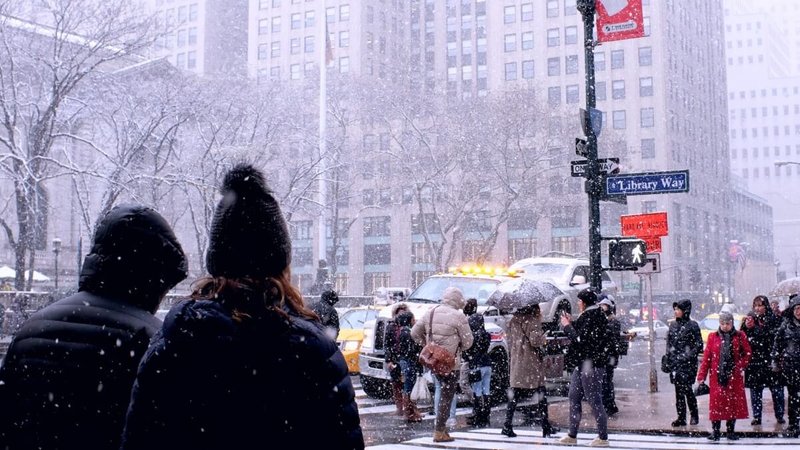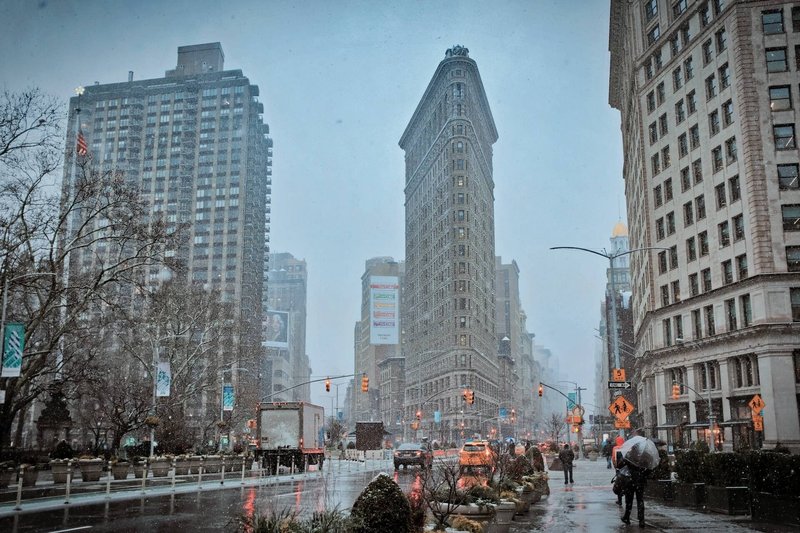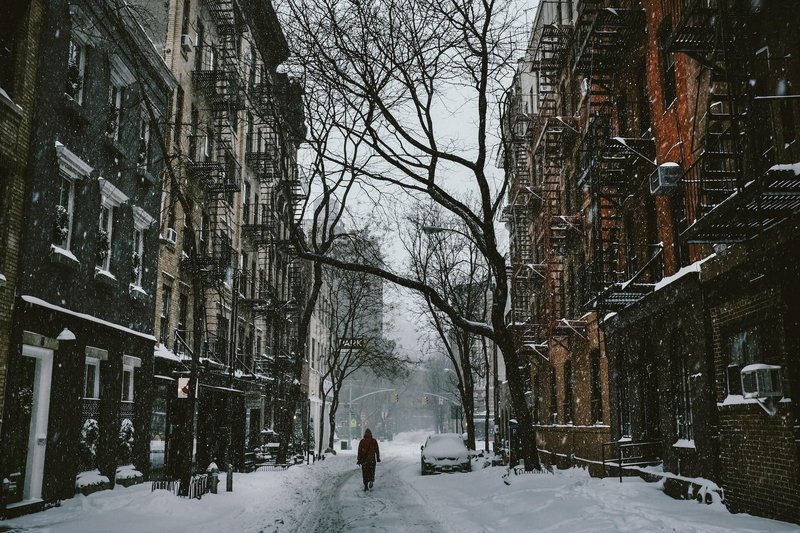Winter Blues Hit NYC College Students
United States North America Higher Education News International Studies Statistics by Erudera News Jan 03, 2024

When the early winter begins, the bustling city of New York is no longer as lively as it is during the summer. The cold weather in the Big Apple goes beyond the streets and breaks through the lives of all.
Usually, the early nightfall brings a sense of lethargy and seasonal depression. This intensifies the battle with mental health for many New Yorkers, especially college students who often feel tired and down during the winter months.
Many people report experiencing depression in the winter, commonly known as “the winter blues.” The medical term for this type of depression, which usually hits in late autumn or early winter, is Seasonal Affective Disorder (SAD).
Nearly 25 percent of college students in the United States suffer from SAD, experiencing shifts in mood and energy levels, as well as difficulties in focusing due to low serotonin levels.
“The seasons tend to impact me academically for multiple reasons. During the winter time, it’s very cold, and it gets dark early. This can result in a lack of motivation and seasonal depression, and can also lead to not wanting to put my best foot forward academically. Most of the time, I would just want to go home and be in my comfort zone,” says sociology student at Hunter College, Angeline Hyppolite.
Hyppolite’s words reflect a wider concern raised by many individuals in the city, shedding light on the deep impact that weather change has on mental health as well as academic motivation.
The National Institute of Mental Health (NIMH) states that SAD is characterized by depressive symptoms that significantly impact one’s ability to function at school, work, and in relationships.
This condition is associated with a chemical imbalance in the brain triggered by the reduction in daylight hours and lack of sunlight during the winter months, with January and February being particularly challenging for many SAD sufferers.
According to Norman Rosenthal’s research, women are four times more likely than men to experience seasonal depression, and the onset of this condition is estimated to occur between the ages of 18 and 30.
SAD in NYC Because of Daily Pressures?
To better understand the winter blues or Seasonal Affective Disorder (SAD), we spoke to Mira Vasjari, a mental health professional working in a private clinic in New York City.
Among her many clients, mostly aged 18 to mid-40s, a significant number struggle with their mood or overall wellbeing during the winter months, but some suffer more severely and are diagnosed with SAD.
“New York City is a challenging place, and making a living here is not easy. It is even much harder to live here than in any other state. College students living in New York face more financial hardships,” she said.
Vasjari explained that some of the reasons that might make it harder for residents in the city of New York, including students, are rent expenses, overall financial responsibilities, or even the hard work to get a degree.
“Rent expenses, commuting expenses, rushing to catch buses/trains, overall finance responsibilities on top of working to get a degree make it even more difficult to sustain an overall good wellbeing. Students in NYC are dealing with more stress due to the city they live in,” she said.
New York City is one of the most expensive cities in the world. According to the Economist Intelligence Unit’s Worldwide Cost of Living survey, the city ranked as the third most expensive in 2023, falling just behind Singapore and Zurich.
In 2022, New York City held the same position as Singapore, while in 2023, it shared the third spot with Geneva, Switzerland.
The clinician notes that for students diagnosed with Seasonal Affective Disorder (SAD), winter months pose additional hurdles. One of the challenges is having a hard time concentrating.
“When someone is depressed, they are in a state of low energy (sometimes even physical pain), might be struggling with sleep (not getting enough or sleeping too much), have no motivation, and have a very difficult time concentrating. These symptoms might make it incredibly difficult to accomplish school responsibilities,” Vasjari explained.
Up to one million New Yorkers experience Seasonal Affective Disorder (SAD), and an additional 10 to 20 percent struggle with a milder manifestation of the condition.

© Serge Pelletier / Unsplash
According to recent data from the New York Health Foundation surveys, over 31 percent of New Yorkers reported worsened mental health in March 2023, meaning the figure remained the same from May 2021, when 32 percent of residents reported poor mental health.
The same found that throughout the pandemic, there were shifts in the rates of poor mental health among New Yorkers. February 2021 saw 40.2 percent of residents reporting anxiety and/or depression. In September 2022, the figure reached 37.2 percent.
Sun and Mental Health
One of the reasons why SAD is mostly present in winter is less sunlight, which leads to a drop in serotonin levels.
Lea Lajqi, a psychology graduate actively researching depression, explains that lack of exposure to sunlight in the winter months can have a deep impact on the body’s normal functioning.
During her academic pursuits, she analyzed how reduced levels of sunlight can also lead to academic stress, worsening anxiety and depression symptoms.
“Cold weather can influence student mental health through various pathways. Reduced exposure to sunlight during winter can disrupt the body’s natural rhythm, affecting mood-regulating neurotransmitters like serotonin. Coupled with academic stressors, this can contribute to heightened levels of stress and anxiety and, in some cases, exacerbate symptoms of depression,” she told Erudera News.
Less sunlight is also challenging for current student Angeline Hyppolite, 23, who would rather attend classes during summer if she had to choose between winter and summer to go to school.
“During spring and summer, it can either go really good or bad. Sometimes, because I am getting enough sunlight and it is nice outside, I can be motivated to go to school and not have to worry about bundling up; however, in the same sense, because it is nice outside and my friends who are not in school are hanging out, I feel like I am missing out on the fun and may also fall off track from school. If I had to pick between the two, I would rather attend classes when it is warmer outside,“ Hyppolite said.
Psychotherapist Mira Vasjari suggests different paths for universities to better support students facing SAD. Beyond the current mental health services, creating awareness among staff about students’ mental health needs is crucial, she said.
Moreover, she highlighted safe spaces on campus, wellness centers, peer support groups, and crisis intervention services can form a comprehensive support system for struggling students.
She went on to explain the signs of SAD, stating that recognizing the signs is essential for timely intervention. According to her, loss of interest, changes in sleep patterns, fatigue, and thoughts of self-harm are red flags that require attention.
“Students aware of struggling more emotionally during the winter months need to pay attention to the pattern. As soon as the day starts getting shorter and colder, they need to be more attentive to their overall wellbeing. They must prioritize taking care of their mental health during the months of November to late February, where we see the spike,” she said.
According to Vasjari, coping mechanisms, including exercise, exposure to natural light, maintaining social connections, and seeking therapeutic support, are vital tools for navigating the winter blues successfully.
Usually, light therapy is used as a remedy for SAD, meaning those experiencing this type of depression can sit in front of a very bright light box. This treatment should last about 30 to 45 minutes every.
NIMH notes that light therapy has been used to treat winter SAD since the 1980s. Nonetheless, several other options help people with SAD, including talk therapy, Vitamin D supplements, or antidepressant medication.
Commute, Weather, and Academic Life
Growing up in Long Island, the situation is not the same for Joe Maselli, 26, a finance graduate who is familiar with the changing weather that defines the city.
While admitting that commuting to Manhattan for classes during cold and bitter weather was less enjoyable, he said he would not consider it a significant factor in his academic experience, highlighting the privilege of receiving an education in the vibrant city.
“Growing up in New York, I became accustomed to the changing seasons from an early age. For this reason, the swings in temperature and daylight were never an outlying factor in my academic performance. Although this variable wasn’t reflected directly in my academic marks, it was subtly less enjoyable commuting into Manhattan for classes when the weather was cold and bitter,” he said.
“Nonetheless, I wouldn’t consider it a significant factor in my academic experience. Getting an education in NYC is a privilege that should be properly appreciated.”

© Chanan Greenblatt / Unsplash
In maintaining a positive mindset during his studies, Maselli said he found some strategies helpful, including adopting a long-term mindset concerning his academic and professional goals or avoiding focusing on short-term results to continue working hard on his studies.
“Above all specific strategies, I believe the primary variable in maintaining a benevolent outlook is to view formal education as a privilege, not a task. Framing it this way makes me remember that I’m very fortunate to have the opportunity to learn and improve instead of viewing it as “work” that needs to be completed, but perhaps without embracement.”
In 2019, depression and anxiety ranked among the top 25 leading causes of burden around the world, according to the Global Burden of Diseases, Injuries, and Risk Factors Study (GBD). The World Health Organization foresees that by 2030, depression will top the list of global health challenges.
A survey published by Gallup and the Lumina Foundation in 2022, found that two out of five undergraduate students admitted to often feeling emotional stress while attending college.
Over 40 percent of students pursuing an undergraduate degree considered dropping out that year, an increase from 34 percent of people considering the same in the first year of COVID-19.
Related:
>> Survey: Over Half of US University Students Stressed About Finances Due to Inflation
>> Students of Color Face Higher Levels of Anxiety & Depression
>> University Students Report Poor Mental Health, 43% Say They Need Professional Help
Main Picture by Yaoqi | Unsplash
Recent Articles
United States
May 17, 2024
United States
May 16, 2024
United States
May 16, 2024
United States
May 15, 2024
Australia
May 15, 2024


